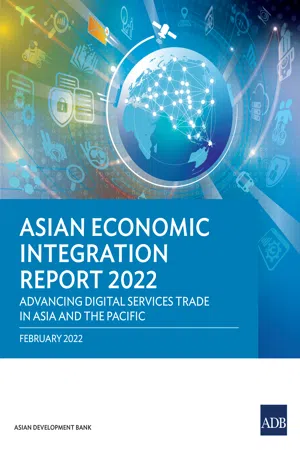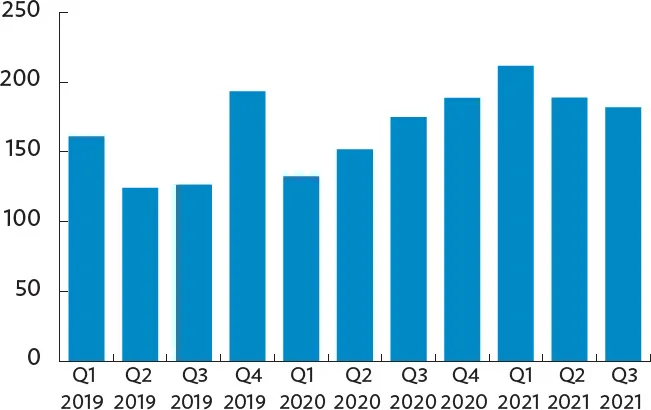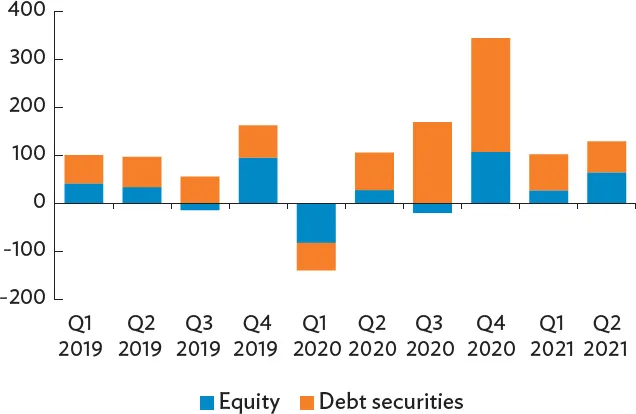
eBook - ePub
Asian Economic Integration Report 2022
Advancing Digital Services Trade in Asia and the Pacific-Main Report
This is a test
Partager le livre
- 300 pages
- English
- ePUB (adapté aux mobiles)
- Disponible sur iOS et Android
eBook - ePub
Asian Economic Integration Report 2022
Advancing Digital Services Trade in Asia and the Pacific-Main Report
Détails du livre
Aperçu du livre
Table des matières
Citations
À propos de ce livre
Another year into the coronavirus disease (COVID-19) pandemic, this report describes an Asia and Pacific region that has more experience in tackling pandemic hardships, better data showing positive integration trends, and greater confidence in regional cooperation to address shared concerns. As rapid digitalization and the COVID-19 pandemic are spurring growth of digital services trade in Asia and the Pacific, the theme chapter explores how the region can capitalize on greater opportunities for digital services trade through structural reforms and international cooperation.
Foire aux questions
Comment puis-je résilier mon abonnement ?
Il vous suffit de vous rendre dans la section compte dans paramètres et de cliquer sur « Résilier l’abonnement ». C’est aussi simple que cela ! Une fois que vous aurez résilié votre abonnement, il restera actif pour le reste de la période pour laquelle vous avez payé. Découvrez-en plus ici.
Puis-je / comment puis-je télécharger des livres ?
Pour le moment, tous nos livres en format ePub adaptés aux mobiles peuvent être téléchargés via l’application. La plupart de nos PDF sont également disponibles en téléchargement et les autres seront téléchargeables très prochainement. Découvrez-en plus ici.
Quelle est la différence entre les formules tarifaires ?
Les deux abonnements vous donnent un accès complet à la bibliothèque et à toutes les fonctionnalités de Perlego. Les seules différences sont les tarifs ainsi que la période d’abonnement : avec l’abonnement annuel, vous économiserez environ 30 % par rapport à 12 mois d’abonnement mensuel.
Qu’est-ce que Perlego ?
Nous sommes un service d’abonnement à des ouvrages universitaires en ligne, où vous pouvez accéder à toute une bibliothèque pour un prix inférieur à celui d’un seul livre par mois. Avec plus d’un million de livres sur plus de 1 000 sujets, nous avons ce qu’il vous faut ! Découvrez-en plus ici.
Prenez-vous en charge la synthèse vocale ?
Recherchez le symbole Écouter sur votre prochain livre pour voir si vous pouvez l’écouter. L’outil Écouter lit le texte à haute voix pour vous, en surlignant le passage qui est en cours de lecture. Vous pouvez le mettre sur pause, l’accélérer ou le ralentir. Découvrez-en plus ici.
Est-ce que Asian Economic Integration Report 2022 est un PDF/ePUB en ligne ?
Oui, vous pouvez accéder à Asian Economic Integration Report 2022 par en format PDF et/ou ePUB ainsi qu’à d’autres livres populaires dans Politics & International Relations et Local & Regional Planning Public Policy. Nous disposons de plus d’un million d’ouvrages à découvrir dans notre catalogue.
Informations
1 Fragile, Uneven Recovery amid the Pandemic

Asia and Pacific economies ramped up COVID-19 vaccinations in 2021, but remain behind other regions.
The surge in coronavirus disease (COVID-19) cases from the second half of 2021 as more transmissible COVID-19 variants spread underlines the importance of speeding and scaling up vaccination programs in the region. Immunization of a large proportion of the population remains the key policy priority for ending the ongoing health crisis and preventing the emergence of more virulent strains which may threaten the efficacy of existing vaccines. High immunization rate will allow gradual and steady reopening of economies, which will support strong and stable economic recovery. But the gradual reopening of economies and borders were stopped toward the end of 2021 as economies, including those in Asia and the Pacific, prevented the spread of the Omicron variant.
As of 31 December 2021, about 69% of people in Asia and the Pacific were either fully or partially vaccinated. The region was behind North America at 74% and Latin America at 70%, but was ahead of Europe, the Middle East, and Africa (Figure 1.1). Within Asia and the Pacific, the East Asia subregion recorded the highest vaccination rate at more than 86% (Figure 1.2), followed by Australia and New Zealand at 80%, Southeast Asia at 61%, South Asia at 57%, and Central Asia at 48% of their total population fully or partially vaccinated. The Pacific subregion had vaccinated only 14% of its population as of third week of December 2021.
Figure 1.1: COVID-19—Vaccinated People, by Region (% of population)

COVID-19 = coronavirus disease, EU = European Union (27 members).
Note: Data are as of the end of December 2021, except for the Pacific, which is as of the third week of December 2021.
Source: ADB calculations using data from Our World in Data and United Nations downloaded from CEIC Data Company.
Figure 1.2: COVID-19—Vaccinated People, by Subregion in Asia and the Pacific (% of population)

AUS = Australia, COVID-19 = coronavirus disease, NZL = New Zealand.
Note: Data are as of the end of December 2021, except for the Pacific, which is as of the third week of December 2021.
Source: ADB calculations using data from Our World in Data and United Nations downloaded from CEIC Data Company.
The pace of COVID-19 inoculation had gained speed in the second half of 2021 (Figure 1.3). Thirteen of the top 50 economies with highest daily vaccinations per million people as of 31 December 2021 are in Asia and the Pacific. Nonetheless, some economies such as Bhutan, Kazakhstan, Nauru, Papua New Guinea, and Samoa have continued to lag. Continuous and increasing access to COVID-19 vaccines remains a priority for the region along with better information sharing among economies, use of granular or localized quarantine measures, and increasing the capacity of health-care systems, more so as new COVID-19 variants spread.
Figure 1.3: COVID-19—Daily Vaccinations per Million People (latest 7-day rolling average for December 2021)

COVID-19 = coronavirus disease.
Notes: Red bars are Asia and Pacific economies. Data are as of the end of December 2021, except for Tonga, which is as of the third week of December 2021.
Source: Our World in Data downloaded from CEIC Data Company.
While merchandise trade and financial investment flows have improved, trade in services and cross-border movement of people remain sluggish.
The region’s total merchandise trade recovered in the first half of 2021, growing by around 31% compared with the same period in the previous year for selected Asia and Pacific economies (Figure 1.4). The strong recovery in merchandise trade reflects base effects from the trade decline due to strict lockdown measures in the prior year as well as improvement in external demand in the first half of 2021. However, merchandise trade growth slowed in the second half as regional economies imposed enhanced quarantine measures to suppress the rise of new COVID-19 variants and as global supply disruptions intensify. Merchandise trade in the third quarter of 2021 grew by 27.1% from the same quarter of 2020.
Figure 1.4: Merchandise Trade Growth—Selected Asia and Pacific Economies (year-on-year, %)

H = half.
Notes: Merchandise trade is the sum of exports and imports. Asia and the Pacific includes Armenia; Australia; Azerbaijan; Bangladesh; Brunei Darussalam; Cambodia; Georgia; Hong Kong, China; India; Indonesia; Japan; Kazakhstan; the Kyrgyz Republic; Malaysia; Mongolia; Myanmar; Nepal; New Zealand; Pakistan; the People’s Republic of China; the Philippines; the Republic of Korea; Singapore; Sri Lanka; Taipei,China; Tajikistan; Thailand; Uzbekistan, and Viet Nam.
Source: ADB calculations using data from CEIC Data Company.
Foreign direct investment (FDI) in the region continued to rise (Figure 1.5). In the first quarter of 2021, the region’s FDI inflows reported in the Balance of Payments and International Investment Position Statistics and national sources amounted to more than $212 billion, a 60% increase from the same period in 2020.1 The increase in FDI inflows reflected the high volume of mergers and acquisitions. The region’s reported inward FDI growth was larger than for selected economies in other regions including North America and South America. FDI inflows slightly dipped to $182 billion in the third quarter of 2021, but still outpaced those in the same period of 2020 by 4%. The resilience of FDI inflows to Asia and the Pacific mirrors the region’s attractiveness as an investment destination and its stronger economic growth prospects compared with other regions.
Figure 1.5: Inward Foreign Direct Investment—Selected Asia and Pacific Economies ($ billion)

Q = quarter.
Note: Asia and the Pacific includes Armenia; Australia; Azerbaijan; Bangladesh; Brunei Darussalam; Cambodia; Georgia; Hong Kong, China; India; Indonesia; Japan; Kazakhstan; the Kyrgyz Republic; the Lao People’s Democratic Republic; Malaysia; Mongolia; Myanmar; New Zealand; Pakistan; the People’s Republic of China; the Philippines; the Republic of Korea; Singapore; Sri Lanka; Taipei,China; Thailand; Uzbekistan; and Viet Nam.
Source: ADB calculations using data from CEIC Data Company.
Nonresident portfolio inflows for selected Asia and Pacific economies continued to improve in the second quarter (Q2) of 2021 after reporting outflows in Q1 2020 (Figure 1.6). Nonresident debt securities or bond flows registered consecutive quarterly inflows from the second quarter of 2020 through the same quarter of 2021. Nonresident portfolio equity flows, likewise, mostly reported inflows with the exception of the third quarter of 2020, when outflows were last recorded. Positive economic growth outlook and commodity price increases sustained nonresident portfolio inflows. Cross-border financial transactions, specifically remittances, also improved in 2021 (Figure 1.7). Remittances in the first 10 months of 2021 grew for most of the selected Asia and Pacific economies. But for some, remittances declined in the same period the year before. Other regions, such as Latin America and the Caribbean, also reported rising remittances. The expected rise in remittances for 2021 might be due to the economic recovery in host economies and the shift from cash to digital transfers as well as from informal to formal channels (Oxford Business Group 2021).
Figure 1.6: Nonresident Portfolio Inflows—Selected Asia and Pacific Economies ($ billion)

Q = quarter.
Note: Asia and the Pacific includes Armenia; Australia; Azerbaijan; Bangladesh; Brunei Darussalam; Cambodia; Georgia; Hong Kong, China; India; Indonesia; Japan; Kazakhstan; the Kyrgyz Republic; the Lao People’s Democratic Republic; Malaysia; Mongolia; Myanmar; New Zealand; Pakistan; the People’s Republic of China; the Philippines; the Republic of Korea; Singapore; Sri Lanka; Taipei,China; Thailand; and Uzbekistan.
Source: ADB calculations using data from CEIC Data Company.
Figure 1.7: Monthly Remittances Growth—January–October 2021 (year-to-date, %)

Note: Data for Bhutan and Kazakhstan cover the period until July and September, respectively.
Source: ADB calculations using data from national sources.
On the contrary, the region’s trade in services continued to be weak in 2021 (Figure 1.8). Specifically, total trade in services for selected Asia and Pacific economies reached $624 billion in the first quarter of 2021 and $655 billion in the second quarter, both higher than $610 billion recorded in the final quarter of 2020. But these values were way below the pre-pandemic quarterly average value of about $754 billion from 2018 to 2019. Among the categories of trade in services, cross-border travel continued to fall the most in 2021, reaching $57 billion and $53 billion in the first and second quarters of 2021, both significantly below the pre-pandemic quarterly average value of $221 billion. In contrast, telecommunications, computer, and information trade services continued to rise during the pandemic up to 2021, from quarterly average value of about $67 billion in 2018 to 2019 to about $80 billion in 2020 to 2021.
Figure 1.8: Trade in Services for Selected Asia and Pacific Economies ($ billion)

Q = quarter.
Notes: Trade in services is computed as trade in services credits plus debits. Asia and Pacific economies include Armenia; Australia, Cambodia; Fiji; Georgia; Hong Kong, China; India; Indonesia; Japan; Kazakhstan; Malaysia; Nepal; New Zealand; Pakistan; the People’s Republic of China; the Philippines; the Republic of Korea; Singapore; Taipei,China; and Thailand.
Source: ADB calculations using data from International Monetary Fund. Balance of Payments and International Investment Position Statistics. https://data.imf.org/BOP (accessed January 2022).
Among cross-border activities, tourist arrivals in Asia and the Pacific remained depressed in 2021. According to United Nations World Tourism Organization (UNWTO) November 2021 report, 30 destinations in the region stayed completely closed, 9 were partially closed, and 10 have compulsory testing and quarantine measures as the spread of COVID-19 variants prompted authorities to take a more cautious approach in opening their economies to foreign tourists (UNWTO 2021). Moreover, there was clear divergence in tourist arrivals within the region (Figure 1.9). In the second half of 2021, several destination economies, including Australia; Cambodia; New Zealand; and Taipei,China experienced continued declines in tourist arrivals compared with the first half of 2021; while improvements were seen in Georgia; Hong Kong, China; Japan; the Republic of Korea; and Singapore.
Figure 1.9: International Tourist Arrivals (April 2020 = 100)

Source: ADB calculations using data from CEIC Data Company and national so...